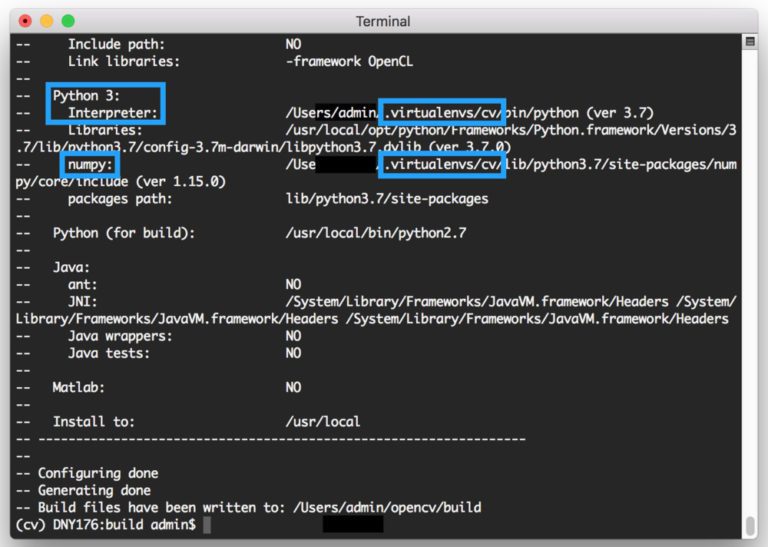- Install Opencv 2 Python Mac
- Install Opencv Python Mac Pip
- Opencv Python Mac Os
- Install Opencv For Python 3.6 Mac
Sudo port selfupdate sudo port install python27 py27-numpy py27-scipy sudo port install opencv +python27 sudo port select -set python python27 Verify your install by running these commands in a new terminal window: python This command will open the python shell, with the version of python and other statement, with a new line starting with. Install OpenCV-Python in Windows¶ Goals¶ In this tutorial. We will learn to setup OpenCV-Python in your Windows system. Below steps are tested in a Windows 7-64 bit machine with Visual Studio 2010 and Visual Studio 2012. The screenshots shows VS2012. OpenCV is a highly optimized library with focus on real-time applications. Cross-Platform C, Python and Java interfaces support Linux, MacOS, Windows, iOS, and Android. The first step we need to do is install Xcode, which is a combination of IDE and software. Opencv and Python Installation for Windows / Mac: OpenCV is an open source computer vision library which is very popular for performing basic image processing tasks such as blurring, image blending, enhancing image as well as video quality, thresholding etc. In addition to image processing, it prov.
The title says it all. What follows is a quick tutorial on how to get OpenCV3 working on your Mac, with Python bindings. I have to say it’s not easy to install it.
Install Opencv 2 Python Mac

Most of this tutorial is based on Satya Mallick’s fantastic tutorial, which I used to get things working. However, I skipped some steps because the virtualenvwrapper Behind for macular degeneration. that Satya (and Adrian Rosebrock from PyImageSearch) suggests to use just did not want to work on my peculiar system (probably a fault of mine).
Anyway, I used a simpler way to install OpenCV, and I think you should install OpenCV this way, too. It’s less annoying.
I’ll also explain some Unix stuff that confused me when I was (more of) a beginner at all this software magic.
Step 0. Install XCode.
If you’re reading this tutorial, then you probably have this already. If not, install it from the App Store. This will be a couple gigabytes and take a while to install.
Step 1. Install Homebrew.
Homebrew is an unofficial package manager for MacOS. It is also the package manager that MacOS needs and deserves. Jump into your terminal and run this command (Don’t copy the $ sign, it’s just a convention to add it at the front of a command):
Install Opencv Python Mac Pip
Now add this line to your hidden .bash_profile file located at your home directory (~). The .bash_profile file is a text file that gets run every time you log-in to a shell (bash is the default shell on Mac, and a “shell” is just an interface where you control the computer with text commands instead of clicks and mouse movements). We want to put set-up code in .bash_profile so that our environment is all set up the way we want when we open our shell.
Side note: If you’re using zsh or other exotic shells, then you probably know what you’re doing and I don’t need to explain.
MAC Velvet Teddy Lipstick Dupes & Swatch Comparisons MAC Velvet Teddy Dupes Here are our dupes for MAC Velvet Teddy, which is a moderately warm-toned, light brown with a matte finish. It is a permanent lipstick that retails for $20.00 and contains 0.1 oz. Mac matte lipstick “velvet teddy” One of the most popular yet so unique, this light brown shades with slight red undertones is the nude everyone has in their wish list. So obviously there are a lot of Mac velvet teddy dupes created which are.  Priced at $17 a piece, MAC's Lipsticks are not the most budget friendly option. If you're a Velvet-Teddy loyalist or simply looking for an amazing lip-enhancing lipstick shade, look no further. Here's a roundup of the best dupes for MAC Cosmetics' Velvet Teddy Lipstick. Have a dupe for MAC's Velvet Teddy Lipstick? THE INTERNET WAS lit up earlier this week when Twitter user Becca McGonigle found a handy dupe for Mac’s much sough after ‘Velvet Teddy’. Any velvet teddy wearers, ‘golden rose’ lipsticks from.
Priced at $17 a piece, MAC's Lipsticks are not the most budget friendly option. If you're a Velvet-Teddy loyalist or simply looking for an amazing lip-enhancing lipstick shade, look no further. Here's a roundup of the best dupes for MAC Cosmetics' Velvet Teddy Lipstick. Have a dupe for MAC's Velvet Teddy Lipstick? THE INTERNET WAS lit up earlier this week when Twitter user Becca McGonigle found a handy dupe for Mac’s much sough after ‘Velvet Teddy’. Any velvet teddy wearers, ‘golden rose’ lipsticks from.
Inside vim, a ubiquitous text editor, press i to get into insert mode. Paste the following code on a new line:
Note: this is where the $ comes in handy! I don’t want you to execute the above statement, so I didn’t add a $ to signify that it’s NOT a command to run.
Here we have something called an environment variable. Here we’re modifying PATH. We are prepending a new file directory /usr/local/bin so that bash looks for stuff in this directory first before searching in other paths inside our current PATH variable, whose values can be accessed with $PATH. This path is exported so that other programs can access it too.
To save and quit vim, press Esc and type :wq for write -> quit.
Side note: Why do we need Homebrew? Because we’ll install Python and OpenCV through Homebrew instead of labouring over it ourselves.
Step 2. Install a verion of Python with Homebrew.
I recommend installing both Python 2.7 and Python 3.6.
There already exists a system version of Python 2.7 (located in /System/Library/Frameworks/Python.framework/Versions) that’s shipped with MacOS. That’s why you can type python in the terminal and a Python interpreter appears. The reason we want to double up and, say, python2.7 with Homebrew (stored in a different directory on the computer) is because it’s bad practice to do software development on the system’s install. If you screw up the system’s python version, then the system is screwed as it depends on that python install to run itself. If you screw up a python version that’s not involved in system routines, then you can delete it and restart–no problems.
Step 3. Make and activate a virtualenv.

This is the part where other tutorials tell you to install virtualenvwrapper. You don’t need it. It’s an added bonus, but it’s also an added level of complexity. We’ll just use a virtualenv (without the wrapper).
Use pip, a python package manager.
Now, what’s this virtualenv business? Jackson, you’ve told me to install new python versions, and then on top of this install a virtual environment?
I never appreciated virtualenvs when I started off coding, but now–three years later–I strictly do not start a project without having made one. A virtualenv keeps duplicated your python install (yet again!) in its own little directory, usually named venv though you can name it dinosaur if you want. That way, you can use pip to install exactly what you need for that project: the right versions of the packages, etc. When you don’t have a virtualenv, you’re using python packages that are shared across multiple projects, and versions start to conflict, and you’ll understand why virtualenvs are necessary. You don’t have to understand it now… But you will some day :)
Now create a virtual environment somewhere. I put it in the ~.
You’ve made your house. Now you need to live inside it. Do this by activating the virtual environment by running the built-in Unix source command executes the code in a supplied file.
Opencv Python Mac Os
FYI, activate is the binary file (hence why it lives in the binary directory of the virtualenv) that activates the virtualenv. We are simply running it with source.
Step 4. Install OpenCV

That’s it. You don’t need anything else. At least I didn’t. This might take an hour.
Step 5. Link stuff together!
This is were Satya’s tutorial comes to the rescue.

Install Opencv For Python 3.6 Mac
echois a built-in bash command that writes what you give it to standard output (stdout).OUTPUT > FILENAMEredirects output from stdout to a file by creating a new file of that name, or overwriting an existing file with the same name.OUTPUT >> FILENAMEredirects output from stdout to a file. Instead of overwriting an existing file,>>appends the output to the existing file.
Combining the above knowledge, the command below simply:
- writes or appends the string
/usr/local/opt/opencv/lib/python3.6/site-packagesto a new/existing file located at/usr/local/lib/python3.6/site-packages/opencv3.pth
Note: Satya’s tutorial told me to use opencv3 directory but I instead had opencv.
If you ls /usr/local/lib/python3.6/site-packages/, you’ll see opencv3.pth somewhere in there. opencv3.pth doesn’t actually exist, so you’re really making a new file. >> is used just to be safe.
Now finally run this:
This creates a symbolic link (like a C pointer) called cv2.so (a shared object file) which doesn’t actually contain any of the code. It refers whoever’s trying to use it to instead go to the real thing, located at /usr/local/opt/opencv/lib/python3.6/site-packages/cv2.cpython-36m-darwin.so.
Check if it all worked!
Good luck!
